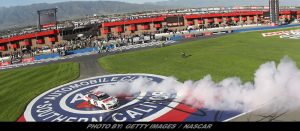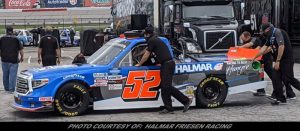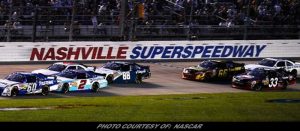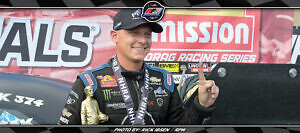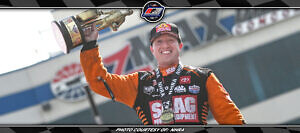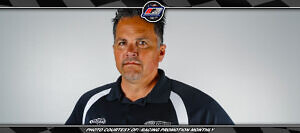
Column By: JOHN DOUGLAS / RPW – LADY LAKE, FL – For the last decade, NASCAR has experienced a steady decline in television viewership, attendance and overall revenue. The reasons are many and the workable solutions are few and far between, so it seems.
Fans say NASCAR is not listening to them. Drivers have said the same. For those that understand that we can’t go back to the 80’s or 90’s, it’s still not hard to see that there’s a major rift in what the fan wants and what the sport is currently providing.
It’s been over a decade since the Generation 5 “C.O.T.” Platform, SAFER Barrier and HANS Device were introduced into the sport. It’s been roughly the same amount of time since we stopped racing back to the yellow flag and the introduction of the Green-White-Checkered finish. These things, as most people in every aspect of the sport agree, have been solid improvements in the sport. Proper evolution as we learn a better, more efficient way to run NASCAR events across the country.
Other changes have not met such universal adoration from fans or teams. Playoff formats, charters, stages, rule books that seem too lenient in certain areas and too stern in others, the dominance of a few powerhouse teams and of course, the on-track action not living up to eras of the past. These concerns are the ones hurting the sport. The issues fans are baffled by, teams are frustrated with and the industry as a whole doesn’t seem to have a good answer for.
However, it’s not lost on this writer just how hard every single person in NASCAR is working right now to make a newer, better product that appeals to fans, sponsors, drivers, team owners and television networks alike. At a time where it’s vital to get things right, it’s most likely impossible for everyone to get exactly what they want…and that’s okay.
With so many players involved in the sport today, it’s almost a certainty that from here on out, the name of this game will be compromise.
Fans want passing, emotion and the anxious feeling of the unknown. Spectators at racing events are from all walks of life and some are more understanding of this sport than are given credit for. Yet, many get on social media and do the same thing they’ve accused NASCAR of doing…throwing spaghetti at the wall and seeing what sticks, myself included.
When fans get on twitter and toss a myriad of ideas at NASCAR, they send a mix of signals to those who are looking for the next changes to make to the overall experience.
One fan says more crashing. Another says we need to go back to biased ply tires and yet another is stumping for North Wilkesboro to come back. Fans need a more unified voice. Instead, we see Jeff Gluck’s ‘was this race good?’ poll on Twitter and find fans saying that races with passing for the lead but no crashes were awful and vice versa.
NASCAR’s fan base has an identity crisis. Do the majority of fans watch for ‘good hard racing,’ or want a ‘big one’ every week? Hardcore fans of the sport mostly appreciate good racing. Casual fans usually watch for the wrecks by traditional trains of thought.
In the past, NASCAR wasn’t very concerned with the reasoning as to why casual fans watched the sport. They were too busy trying to become a legitimate sporting event in the eyes of the general public and mainstream media.
The television media in general does a wonderful job of spending money and putting a top tier broadcast package together for NASCAR. They however, in the eyes of many, don’t do good enough telling the whole story as they once did. Wider camera angles, more focus on mid-pack action, less advertisement, more interaction with the viewers, more realistic commentary that doesn’t pull punches. All things that would improve the sport’s image in a time when a NASCAR garage feels more like a Formula One paddock than ever before.
The problem is, it takes advertising money to pay for everything you see. Either we cater to advertisers or we don’t have coverage. If we don’t have coverage we have nothing at all. I’ll take what we have now over nothing at all.
The balance of pleasing corporate partners and somehow appeasing fans is becoming harder to find. Corporate interests want tighter camera angles so their logos are bigger on your TV screen. You, the fan, want the wider angle so you can see more action. It’s hard to find compromise between two opposing views such as this.
So 63 cameras and side-by-side commercials later, they give us what they believe is the best balance they can achieve to please sponsors and fans alike. TV Networks and NASCAR aren’t worried about making you 100% happy with everything they do. Nor are they interested in 100% catering to corporate interests. They know if they can get a 85% on this weekly test, they’ll pass. It’s the best balance they can find.
Progress is supposed to be a move forward…a move for the better…not change for the sake of change. If 550hp engines, tall spoilers and aero ducts give you the same tingly feeling I had as an eight yr. old watching men manhandle 800hp beasts that did NOT want to cooperate with their pilots, then I consider you lucky. Keep that feeling as long as possible because that’s what hooked people on this sport to begin with..the real and palpable sense that danger did, in fact, lurk around every turn.
It’s not that fans want the possibility of a driver getting hurt. It’s the idea that no matter how hard we try, there is inherent risk involved. It comes with the territory of choosing to make driving a race car the way you make your living. NASCAR running a 550hp ‘restricted’ engine, which is less than the current Shelby GT 500 Mustang from the Ford factory for public use on public roads, does not illicit a sense of cutting edge technology that can bring a man to the very peak of his ability to handle a 3,000lb racing machine.
Regardless of what racing action we have seen on the track so far in 2019, the one image I have come to associate with the 2019 rules package so far is Kevin Harvick driving down the curved front stretch at Las Vegas with one hand on the wheel as if he were taking a leisurely Sunday drive to the grocery store for some milk. That one image sells this sport as “easy.” It’s not supposed to be easy.
We mustn’t forget though that NASCAR also has other interests at play that lead them to their decisions. Politics behind the scenes that no media member or fan is privy to. Corporate partners are certainly giving ideas and even directives to NASCAR on how to market, promote and even operate this sport. Certain decisions are made because that’s what the people who write the checks want.
It’s the same on the track. Manufacturers and corporate interests want to appeal to the mainstream auto market. The saying for them still holds true…”Win on Sunday, sell on Monday.” However, they also understand that the landscape of America’s roadways has changed. The single most used engine on the roads of America today is no longer the V-8. They believe a race car that more closely mimics the street car you drive will be more relevant to selling cars in their dealerships.
The 1970’s brought about a glaring example of a shift in that dynamic.
The horsepower wars and insane designs of the early 70’s brought about a real problem just a few years later when the fuel crisis hit the U.S.. Emissions controls and horsepower reductions to conserve fuel hit everyone, including NASCAR. The sport responded by switching from Big-Blocks to Small-Block V-8’s…a drastic shift in how NASCAR appeared to the viewer.
One possible answer being discussed in the rumor mills as we await the unveiling of NASCAR’s Gen. 7 car is the possibility of a smaller ‘open’ motor. Possibly a 305 cubic inch engine. A move that would allow NASCAR to continue running a V-8 engine, reduce overall top speed, yet allow for more throttle response than the current 2019 package. This could be the compromise fans and manufacturers need.
Currently, the 2019 package feels like nothing more than a stop gap. The sport is in a holding pattern, waiting until the Gen. 7 car comes along. A more stock looking appearance, a new engine package and new era of the sport possibly awaits us when that car is unveiled. One where most of the complaints many in the sport have will attempt to be addressed.
They only thing NASCAR really needs is time. Time to allow those who now run the sport to have their influence felt…Jim France being on the top of that list. France’s passion is strong for making NASCAR successful again. We saw it first hand when he inferred that more drivers needed to run the bottom line at Daytona during February’s Daytona 500 driver’s meeting.
If fans, sponsors and TV Networks give NASCAR the time they need, we very well could be in store for another special era in NASCAR’s history…an era where competition is again at a level where people feel drawn to the sport because it’s a ‘must see’ event.
It also could be an era where TV Networks put better broadcasts out to the viewers because there are enough story-lines and on-track moments to keep things interesting to the viewer regardless of there being a few too many commercials. It also might be an era where NASCAR again feels like a sport based on the concept that drivers are risk takers who ride on the ragged edge for 4-5 hours every weekend.
Only time will tell and only patience from fans will allow it to take fruition.

